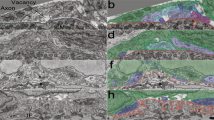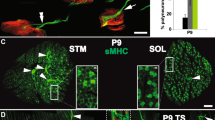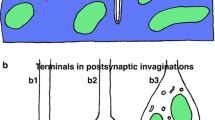Abstract
In the establishment of connections between nerve and muscle there is an initial stage when each muscle fibre is innervated by several different motor axons. Withdrawal of connections then takes place until each fibre has contact from just a single axon. The evidence suggests that the withdrawal process involves competition between nerve terminals. We examine in formal models several types of competitive mechanism that have been proposed for this phenomenon. We show that a model which combines competition for a presynaptic resource with competition for a postsynaptic resource is superior to others. This model accounts for many anatomical and physiological findings and has a biologically plausible implementation. Intrinsic withdrawal appears to be a side effect of the competitive mechanism rather than a separate non-competitive feature. The model's capabilities are confirmed by theoretical analysis and full scale computer simulations.
Similar content being viewed by others
References
Bennett MR, Robinson J (1989) Growth and elimination of nerve terminals during polyneuronal innervation of muscle cells: a trophic hypothesis. Proc R Soc Lond [Biol] 235: 299–320.
Betz WJ, Caldwell JH, Ribchester RR (1979) The size of motor units during post-natal development of rat lumbrical muscle. J Physiol (London) 297:463–478
Betz WJ, Caldwell JH, Ribchester RR (1980) The effects of partial denervation at birth on the development of muscle fibres and motor units in rat lumbrical muscle. J Physiol (London) 303:265–279
Brown MC, Jansen JKS, van Essen DC (1976) Polyneuronal innervation of skeletal muscle in new-born rats and its elimination during maturation. J Physiol (London) 261:387–422
Fladby T, Jansen JKS (1987) Postnatal loss of synaptic terminals in the partially denervated mouse soleus muscle. Acta Physiol Scand 129:239–246
Fladby T, Jansen JKS (1988) Selective innervation of neonatal fast and slow fibres before a net loss of synaptic terminals in mouse soleus muscle. Acta Physiol Scand 134:561–562
Gordon H, van Essen DC (1981) Motor units diversify in size as synapse elimination proceeds in the neonatal rabbit soleus muscle. Soc N Sci 7:179
Gouzé JL, Lasry JM, Changeux JP (1983) Selective stabilization of muscle innervation during development: A mathematical model. Biol Cybern 46:207–215
Jansen JKS, Fladby T (1990) The perinatal reorganization of the innervation of skeletal muscle in mammals. Prog Neurobiol 34:39–90
Laskowski MB, Sanes JR (1988) Topographically selective reinnervation of adult mammalian skeletal muscles. J Neurosci 8:3097–3099
Lichtman J (1977) The reorganization of synaptic connections in the rat submandibular ganglion during postnatal development. J Physiol (London) 273:155–177
McArdle JJ (1975) Complex endplate potentials at regenerating neuromuscular junction of the rat. Exp Neurol 49:629–638
O'Brien RAD, Ostberg ASC, Vrbova G (1978) Observations on the elimination of polyneuronal innervation in developing mammalian skeletal muscle. J Physiol (Lond) 282: 571–582.
Redfern PA (1970) Neuromuscular transmission in newborn rats. J Physiol (Lond) 209:701–709
Ribchester RR (1988) Activity-dependent and -independent synaptic interactions during reinnervation of partially denervated rat muscle. J Physiol (Lond) 401:53–75
Ribchester RR, Taxt T (1983) Motor unit size and synaptic competition in rat lumbrical muscles reinnervated by active and inactive motor axons. J Physiol (Lond) 344:89–111
Thompson WJ (1985) Activity and synapse elimination at the neuromuscular junction. Cell Mol Neurobiol 5:167–182
Thompson WJ, Jansen JKS (1977) The extent of sprouting of remaining motor units in partly denervated immature and adult rat soleus muscle. Neuroscience 4:523–535
Malsburg C von der (1973) Self-organization of orientation sensitive cells in the striate cortex. Kybernetik 14:85–100
Willshaw DJ (1981) The establishment and the subsequent elimination f polyneural innervation of developing muscle: theoretical considerations. Proc R Soc London Ser B 212:233–252
Willshaw DJ, Malsburg C von der (1979) A marker induction mechanism for the establishment of ordered neural mappings: Its application to the retinotectal problem. Proc R Soc London Ser B 287:203–234
Author information
Authors and Affiliations
Rights and permissions
About this article
Cite this article
Rasmussen, C.E., Willshaw, D.J. Presynaptic and postsynaptic competition in models for the development of neuromuscular connections. Biol. Cybern. 68, 409–419 (1993). https://doi.org/10.1007/BF00198773
Received:
Accepted:
Issue Date:
DOI: https://doi.org/10.1007/BF00198773




